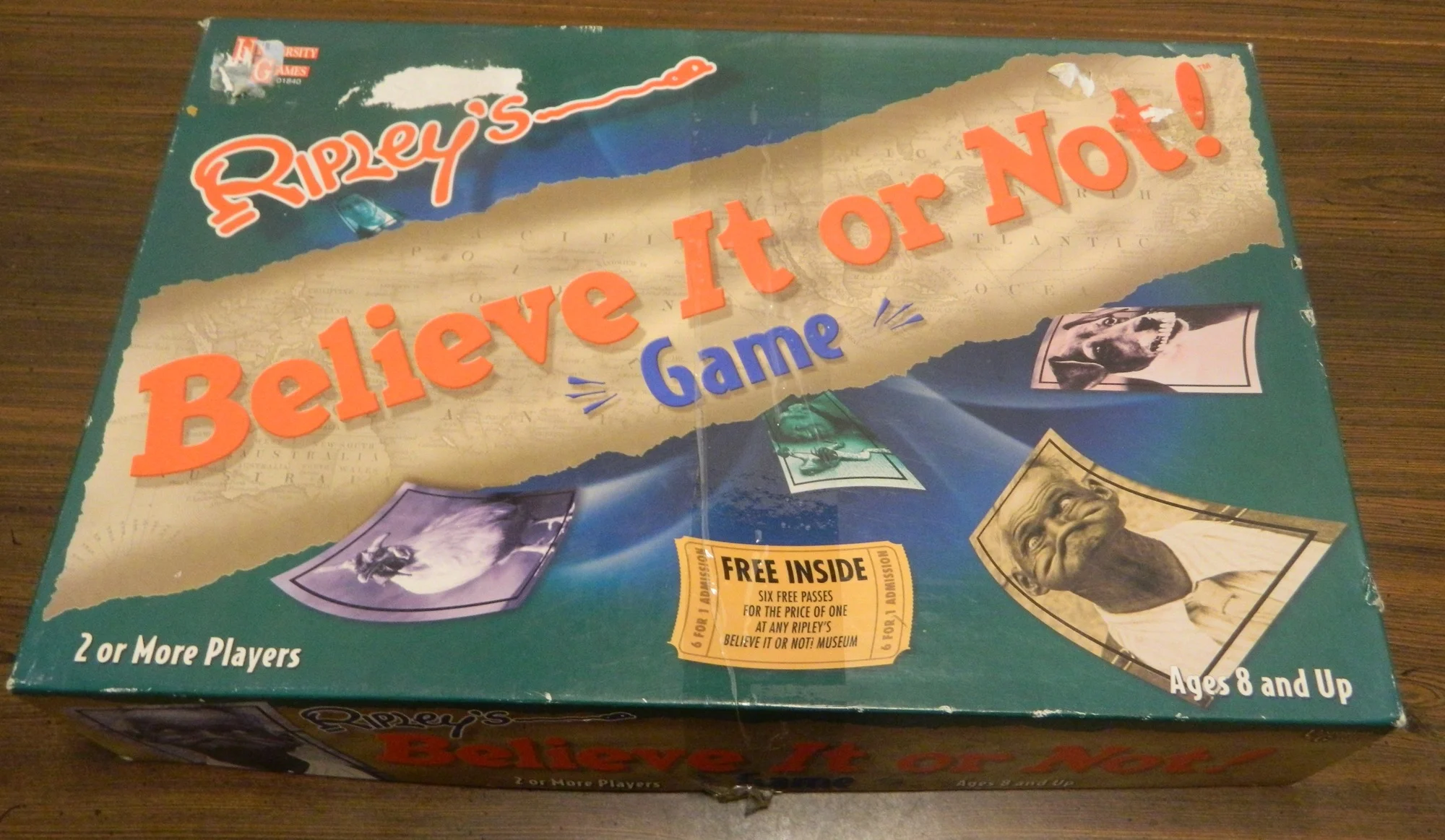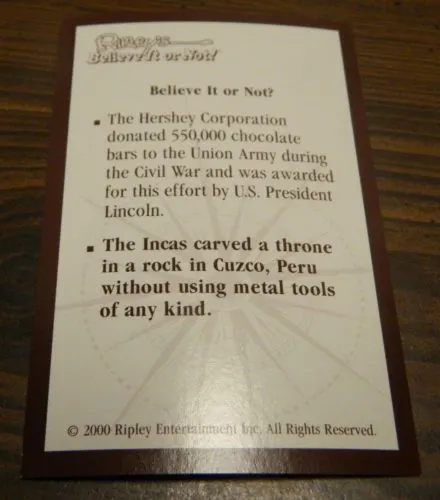For those unfamiliar with Ripley’s Believe It or Not!, it is an entertainment franchise focused on the weird and unusual. Originally starting as a newspaper column it eventually spawned books, a radio show, several TV shows, and museum attractions all over the world. Ripley’s Believe It or Not! has even inspired five different board games and today I am looking at the 2000 version of the game. Being a fan of weird and unusual facts I was interested in trying out the Ripley’s Believe It or Not! Game because I thought it was going to be a trivia game based on strange facts. While the Ripley’s Believe It or Not! Game could have been a good game, the game is so focused on adding unnecessary mechanics that it ruins the game.
How to Play the Ripley’s Believe It or Not! Game
Setup
- Each player chooses a playing piece and a right/wrong token.
- Place the “top trivia card” on top of the stack of trivia cards and place the stack of trivia cards on top of the picture of the penguin. Place the exhibit picture deck (picture side up) on top of the photo of the ball.
- Shuffle the visa card deck and deal one card to each player. Each player places their playing piece on the continent corresponding to the visa card that they are dealt. Each player then places their visa card on the bottom of the visa deck.
- Each player is dealt 3 visa cards and the rest of the cards form the draw pile which is placed on top of the acrobat on the gameboard.
- Players choose whether they are going to use the top or bottom question from the trivia cards.
- The youngest player starts the game.
Collecting Visa Cards
A player begins their turn by rolling the die. The player moves their playing piece the number of spaces they rolled. While moving players can move their piece in any direction but may not change directions while moving. Players can also not change paths on their turn unless they move through a continent space.
While moving if a player lands on a space (not a continent space) occupied by another player, the current player can move the other player’s piece to any continent of their choice.
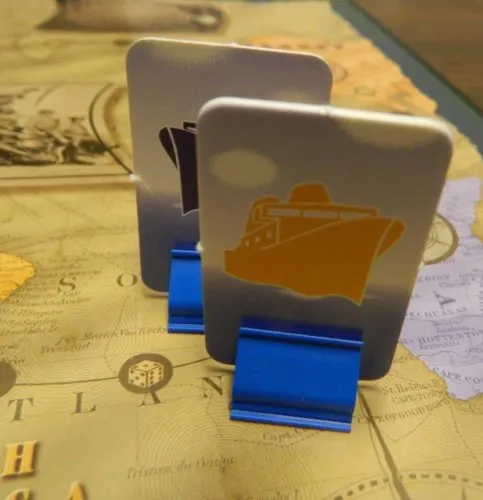
The yellow player has landed on the same space as this other player. The yellow player can move the other player’s playing piece to any continent on the board.
If a player lands on a circle with a die, they get to roll again. If a player lands on a space with a skull and crossbones, the player to their right gets to randomly take one of the visa cards from their hand.
When a player lands on a continent space (does not have to be by exact count), they can choose to stop moving their playing piece to answer a trivia question.
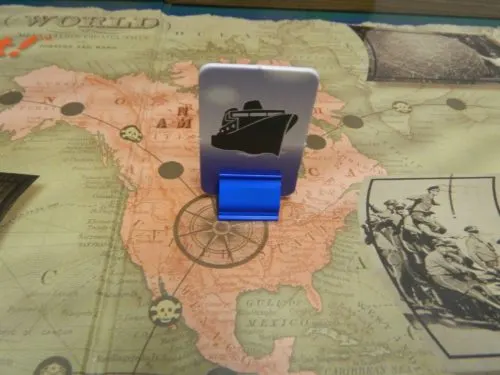
The blue player has landed on North America so they can choose to stop and answer a trivia question.
The player to the left of the current player takes the top card from the trivia card deck and reads the top or bottom statement (depending on what was chosen at the beginning of the game). Each statement is true or false with true statements being printed in bold on the card.
Before the current player guesses whether the statement is true or false, all of the players have a chance to bet on whether the player will guess correctly. Any player that has a visa card that matches the continent that the current player is on, gets to choose whether they want to play the card. If they choose to play the card, they use their right/wrong disc to indicate whether they think the current player will get the question correct. The player then uses the card that matches the current continent to cover up their choice.
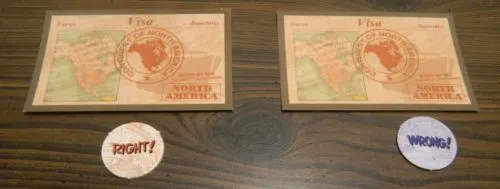
The player on the left has bet that the player will get the question right while the player on the right things they will get it wrong.
The current player then answers whether they think the statement is true or false. All of the players who bet then reveal their bets. The current player will take one of the following actions depending on whether they were right or wrong.
- If the current player guessed correctly they will collect the played cards from the players who bet incorrectly. They also get to take the top card from the visa deck. Finally the current player can play a card that matches the continent they are currently on face up on the table (if they don’t already have a card played for the current continent).
- If the current player is wrong they receive nothing and their turn ends.
The betting players will take actions based on whether they bet correctly or not.
- If a player bets incorrectly they will lose the card that they bet. If the current player got the question correct the card goes to them. If the current player got the question wrong, the visa card is discarded.
- If the player bets correctly they get to keep the visa card in front of themselves face up. The player can only have one face up visa card for each continent though. The player also gets to take the top card from the visa deck.
Once a player has a face up visa card from every continent, they move onto the exhibition phase of the game.
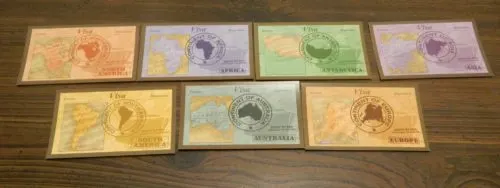
This player has acquired a visa card from every continent so they can move onto the next phase of the game.
Exhibition Cards
In this phase of the game whenever a player reaches a new continent they will answer the top exhibition picture card. Each card has a picture on one side and three statements on the back. One of the three statements corresponds to the picture on the other side.
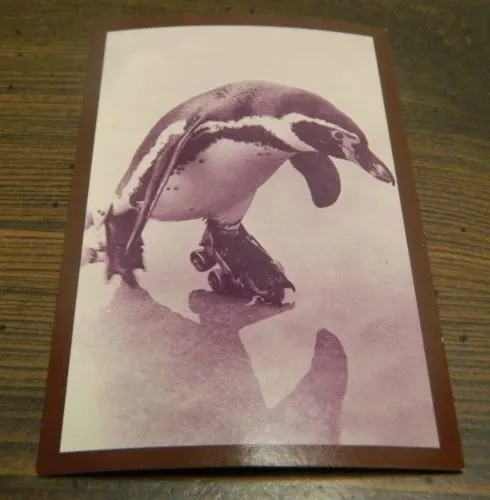
While another player reads the statements on the back, the current player has to determine which applies to this picture.
While the current player reads the three statements the other player looks at the picture. If the current player picks the correct statement (the statement that is bold), they have won the game.
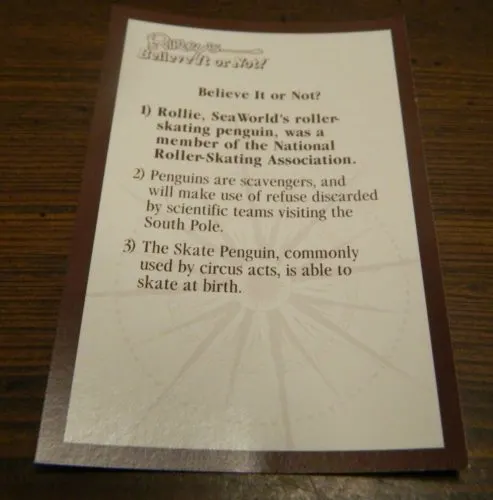
The previous picture was of Rollie, Sea World’s roller skating penguin. If the player guessed correctly they win the game.
If the current player guesses incorrectly, their turn ends. On their next turn they must move towards another continent in order to try another exhibition picture card.
Winning the Game
The first player to correctly answer a exhibition picture card wins the game.
My Thoughts on the Ripley’s Believe It or Not! Game
One of the most popular types of board games is the trivia game. With the genre being so popular it does have some serious problems with originality. Most trivia games consist of asking questions with players earning points for each question they answer correctly. The first player/team that scores a certain amount of points or answers a question correctly in each category first wins the game. With most trivia games basically playing exactly the same I like it when trivia games try to do something original. In the case of the Ripley’s Believe It or Not! Game though, originality is not all its cracked up to be.
The biggest problem with the Ripley’s Believe It or Not! Game is the fact that in it’s attempt to do something original, the game ends up adding a lot of unnecessary mechanics that just feel like a waste of time. Most of your time with the game will involve you moving around the board trying to play a visa card from every continent. This involves a lot of pointless dice rolling as you move between the continents adding luck to a genre that doesn’t need it. I know I love it when trivia games have unnecessary luck added.
While I am not a fan of the dice rolling, the worst mechanic involves the visa cards. The reason I hate the visa cards so much is that they just add luck to the game along with a bunch of semi-confusing and pointless mechanics that do nothing but waste time. A trivia game is supposed to focus on players answering trivia questions correctly. The visa cards force players to get lucky and draw the right visa cards. It doesn’t matter how many questions you get correctly if you can’t draw the last couple of visa cards you need to proceed to the next stage.
In addition to hoping you draw the right visa cards you have to hope that the betting mechanic goes in your favor. I can see that the designers added the betting mechanic to keep players involved when it wasn’t their turn but the mechanic is flawed. First of all for most of the questions you won’t even be able to bet. If you don’t have a card for the current continent or already have one played in front of you, you can’t bet. Even if you can bet on the question it is basically a complete guess since you don’t know the answer to the question and you don’t know what the player is going to answer. Basically you have to just guess and hope you are right since if you are wrong you might be giving the current player a visa card they need. Even though the mechanic is flawed, you basically have to take a risk every so often since it is one of the only ways that you can catch up if you fall behind.
Before playing the Ripley’s Believe It or Not Game I assumed it was just going to be another generic trivia game and after playing the game I think it would have been better if it was. The problem is that every mechanic that they tried to add to the basic trivia gameplay makes the game worse. The visa cards and the board movement mechanics just add unnecessary complexity and time to the game while not actually adding anything of value. If I were ever going to play the game again (very unlikely) I would just eliminate all of these mechanics from the game and just use the question cards like a normal trivia game. I really don’t understand why the designers decided to add all of these pointless mechanics since the 1984 and 2006 versions of the game figured out that it would be best to just get right to the point and be a normal trivia game.
So you might be wondering how good are the trivia questions? While some of the facts are quite interesting, the game kind of drops the ball in this department as well. One problem that I had with the trivia questions was the fact that you basically have to just guess for most of them. There really isn’t even much room to make an educated guess. The only way you can avoid a complete guess is if you have somehow already heard the story or are familiar enough with the topic that you can tell that part of the statement is false. If neither apply to the current question all you can do is guess.
The other problem that I had with the trivia questions is the fact that they give you no extra information. The only information that the cards give you are the statements and which ones are true and which are false. Most of these types of trivia games at least include a couple sentences explaining why the statement is false or some background information if the statement is true. The Ripley’s Believe It or Not! Game doesn’t give you anything though. This is a let down since it would have been nice to learn some additional information about the statements that were actually true. If you are curious about any of the statements you have to look them up yourself in order to get more information.
So you have trudged through a pretty bad trivia game and have finally acquired all seven continent visa cards. You have finally reached what you hope is the final question of the game. At this point in the game you encounter the single redeeming quality of the game, the picture trivia cards. It is odd that the best part of the game takes up so little of the actual game. If the game would have just focused on the picture cards it actually could have been a pretty solid trivia game.
What I like about the picture cards is that they have more to them than just guessing whether a statement is true or false. The picture cards have a picture of the subject of the question and three different statements. Players have to choose which of the three statements actually apply to the picture. I liked these trivia cards a lot more than the normal trivia cards since you can actually make an educated guess. These questions actually feel like real trivia questions instead of simple true or false questions like the rest of the game.
So I didn’t like the Ripley’s Believe It or Not! Game but what about its’ components? Unfortunately the components don’t fare much better. I will give the game credit for including quite a few trivia cards. The game includes 220 normal trivia cards which means that there are 880 statements for the main portion of the game. This is plenty of statements where you likely will never have to repeat a card. The game also includes 110 exhibit picture cards which is enough for the game even though I wish all of the trivia cards would have been photo cards. Other than the quantity of the cards though, the component quality isn’t great. They serve their purpose but feel a little cheap.
Should You Buy the Ripley’s Believe It or Not! Game?
Before playing the Ripley’s Believe It or Not! Game I had some hope for it. A trivia game focused on weird and unique facts could have made for a solid trivia game. The problem with the game is that by trying to distinguish itself from other trivia games, the Ripley’s Believe It or Not! Game actually made itself worse. Outside the trivia questions, all of the game’s other mechanics are pointless. They add unnecessary luck, complexity and time to the game which ruins it. Add in that the normal trivia cards aren’t that interesting and you are left with a pretty dull trivia game. The one saving grace for the game, the picture cards, come into play way too late to save the game.
If you don’t love trivia games or Ripley’s Believe It or Not! I would stay clear of the game since it is not a good trivia game. The only way I could recommend the Ripley’s Believe It or Not! Game is if you love trivia and Ripley’s Believe It or Not! and can get a really good deal on the game.
If you would like to purchase the Ripley’s Believe It or Not! Game, you can find it online: Amazon, eBay

